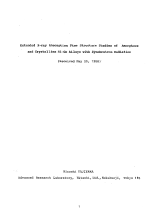Extended X-ray absorption fine structure studies of amorphous and crystalline Si-Ge alloys with synchrotron radiation 放射光を用いたEXAFS法によるSi-Ge合金の研究
Access this Article
Search this Article
Author
Bibliographic Information
- Title
-
Extended X-ray absorption fine structure studies of amorphous and crystalline Si-Ge alloys with synchrotron radiation
- Other Title
-
放射光を用いたEXAFS法によるSi-Ge合金の研究
- Author
-
梶山, 博司
- Author(Another name)
-
カジヤマ, ヒロシ
- University
-
広島大学
- Types of degree
-
理学博士
- Grant ID
-
乙第1773号
- Degree year
-
1988-11-28
Note and Description
博士論文
Extended X-ray absorption fine structure (EXAFS) has been developed to a useful tool for determining the local bonding structure around an X-ray absorbing atom.EXAFS spectra are usually interpreted by a simple formula derived from an electron scattering theory, with the plane wave approximation. A curve-fitting technique gives plausible bond lengths, where the absorbing edge energy, E₀, is used as one of the parameters. Model compounds are necessary to get the reliable structure in most cases. However, in the case of binary or ternary compounds, it is unreasonable to yield different values of E₀ for different neighboring atoms through the curve-fitting procedure. Furthermore, it is difficult to find good model compounds. A new method has been developed here tor the EXAFS analysis, which is based on the spherical wave approach for emitted electrons. This method is proved to give a reliable structure even without model compounds. Ge K-edge EXAFS spectra have been measured for amorphous-Si₁-xGex:H (x=0.27, 0.36, 0.38, o.47, 0.56, 1.0) and crystalline-Si₁-xGex (x=0.2, 0.39, 0.59, 0.81, 1.0), using synchrotron radiation as the photon source.Spectra were analyzed by the newly developed method without using model compounds and by fixing the E₀ value at the steepest point of the absorption edge. Obtained results show that Ge-Ge and Ge-Si bond lengths of amorphous- Si₁-xGex:H are 2.46Å and 2.41Å, respectively, irrespective of Ge concentration. These bond lengths can be interpreted by the sum of the atomic radii of constituent elements as pointed by Bragg and later by Pauling. As for the case of crystalline-Si₁-xGex, the resulted bond lengths of Ge-Ge and Ge-Si were almost similar to the corresponding bond lengths in amorphous-Si₁-xGex:H. The difference of crystalline and amorphous alloys should be only interpreted by the difference of bond angle distortion. A study on the coordination around a Ge atom in amorphous-Si₁-xGe:H revealed that Ge and Si atoms are randomly mixed in the compositional range below 40 atomic percent. In the amorphous alloys with higher Ge content, the coodinations of Ge atoms surrounding a central Ge atoms is 15-20 percent higher than expected for a random mixture, suggesting a structural inhomogeneity in Ge-rich region. Whereas in crystalline Si₁-xGex, it is found that Ge and Si atoms are randomly mixed in the studied compositional range.
